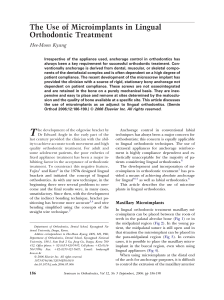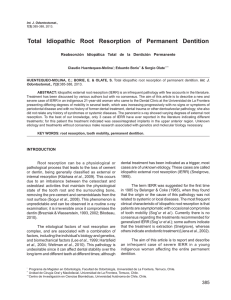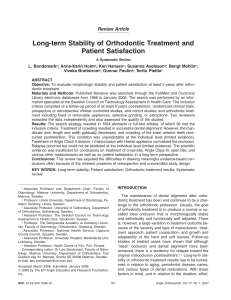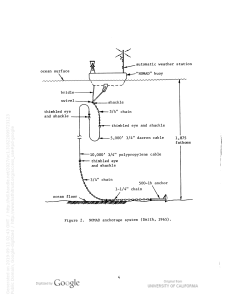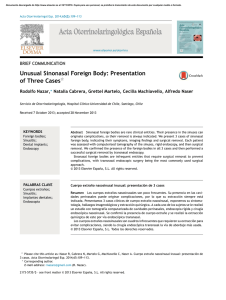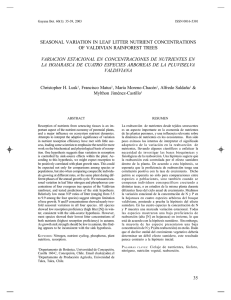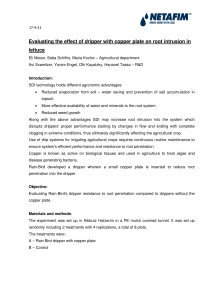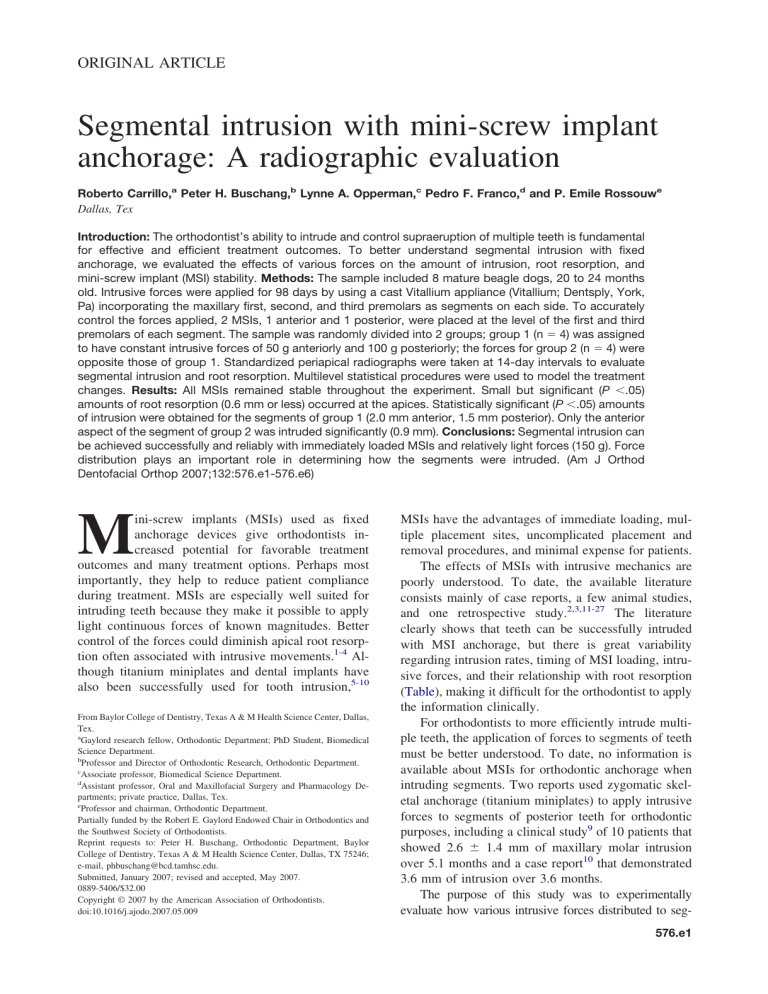
ORIGINAL ARTICLE Segmental intrusion with mini-screw implant anchorage: A radiographic evaluation Roberto Carrillo,a Peter H. Buschang,b Lynne A. Opperman,c Pedro F. Franco,d and P. Emile Rossouwe Dallas, Tex Introduction: The orthodontist’s ability to intrude and control supraeruption of multiple teeth is fundamental for effective and efficient treatment outcomes. To better understand segmental intrusion with fixed anchorage, we evaluated the effects of various forces on the amount of intrusion, root resorption, and mini-screw implant (MSI) stability. Methods: The sample included 8 mature beagle dogs, 20 to 24 months old. Intrusive forces were applied for 98 days by using a cast Vitallium appliance (Vitallium; Dentsply, York, Pa) incorporating the maxillary first, second, and third premolars as segments on each side. To accurately control the forces applied, 2 MSIs, 1 anterior and 1 posterior, were placed at the level of the first and third premolars of each segment. The sample was randomly divided into 2 groups; group 1 (n ⫽ 4) was assigned to have constant intrusive forces of 50 g anteriorly and 100 g posteriorly; the forces for group 2 (n ⫽ 4) were opposite those of group 1. Standardized periapical radiographs were taken at 14-day intervals to evaluate segmental intrusion and root resorption. Multilevel statistical procedures were used to model the treatment changes. Results: All MSIs remained stable throughout the experiment. Small but significant (P ⬍.05) amounts of root resorption (0.6 mm or less) occurred at the apices. Statistically significant (P ⬍.05) amounts of intrusion were obtained for the segments of group 1 (2.0 mm anterior, 1.5 mm posterior). Only the anterior aspect of the segment of group 2 was intruded significantly (0.9 mm). Conclusions: Segmental intrusion can be achieved successfully and reliably with immediately loaded MSIs and relatively light forces (150 g). Force distribution plays an important role in determining how the segments were intruded. (Am J Orthod Dentofacial Orthop 2007;132:576.e1-576.e6) M ini-screw implants (MSIs) used as fixed anchorage devices give orthodontists increased potential for favorable treatment outcomes and many treatment options. Perhaps most importantly, they help to reduce patient compliance during treatment. MSIs are especially well suited for intruding teeth because they make it possible to apply light continuous forces of known magnitudes. Better control of the forces could diminish apical root resorption often associated with intrusive movements.1-4 Although titanium miniplates and dental implants have also been successfully used for tooth intrusion,5-10 From Baylor College of Dentistry, Texas A & M Health Science Center, Dallas, Tex. a Gaylord research fellow, Orthodontic Department; PhD Student, Biomedical Science Department. b Professor and Director of Orthodontic Research, Orthodontic Department. c Associate professor, Biomedical Science Department. d Assistant professor, Oral and Maxillofacial Surgery and Pharmacology Departments; private practice, Dallas, Tex. e Professor and chairman, Orthodontic Department. Partially funded by the Robert E. Gaylord Endowed Chair in Orthodontics and the Southwest Society of Orthodontists. Reprint requests to: Peter H. Buschang, Orthodontic Department, Baylor College of Dentistry, Texas A & M Health Science Center, Dallas, TX 75246; e-mail, phbuschang@bcd.tamhsc.edu. Submitted, January 2007; revised and accepted, May 2007. 0889-5406/$32.00 Copyright © 2007 by the American Association of Orthodontists. doi:10.1016/j.ajodo.2007.05.009 MSIs have the advantages of immediate loading, multiple placement sites, uncomplicated placement and removal procedures, and minimal expense for patients. The effects of MSIs with intrusive mechanics are poorly understood. To date, the available literature consists mainly of case reports, a few animal studies, and one retrospective study.2,3,11-27 The literature clearly shows that teeth can be successfully intruded with MSI anchorage, but there is great variability regarding intrusion rates, timing of MSI loading, intrusive forces, and their relationship with root resorption (Table), making it difficult for the orthodontist to apply the information clinically. For orthodontists to more efficiently intrude multiple teeth, the application of forces to segments of teeth must be better understood. To date, no information is available about MSIs for orthodontic anchorage when intruding segments. Two reports used zygomatic skeletal anchorage (titanium miniplates) to apply intrusive forces to segments of posterior teeth for orthodontic purposes, including a clinical study9 of 10 patients that showed 2.6 ⫾ 1.4 mm of maxillary molar intrusion over 5.1 months and a case report10 that demonstrated 3.6 mm of intrusion over 3.6 months. The purpose of this study was to experimentally evaluate how various intrusive forces distributed to seg576.e1 576.e2 Carrillo et al Table. American Journal of Orthodontics and Dentofacial Orthopedics November 2007 Literature on MSI anchorage for intrusion of teeth Intrusion rate Authors (year) Type Teeth Force Amount (mm) Creekmore and Eklund (1983)11 Kanomi (1997)12 Ohmae et al (2001)2 CR UI NR 6 CR A LI LPm NR 150 g 6 4.5 Park et al (2003)13 Paik et al (2003)14 Chang et al (2004)15 Carano et al (2004)16 Kuroda et al (2004)17 Yao et al (2004)18 Park et al (2004)19 Lee et al (2004)20 Yao et al (2005)21 Ohnishi et al (2005)22 Park et al (2005)23 Bae and Kyung (2006)24 Park et al (2006)25 Lin et al (2006)26 Jeon et al (2006)27 Carrillo et al (2007, in press)3 CR CR CR CR CR CR CR CR R CR CR CR CR CR CR A UM UI-M/LI-M UM/LM UI/UM UM/LM UM UM/LM UM UPm/UM UI UM LM UM/LM UM UM/LM LPm 200-300 g 150-200 g NR NR NR 150-200 g 150 g 150-200 g 300-400 g 20 g 100 g 5 oz 100 g 150-200 g 200 g 50, 100, 200 g 4-6 3-4.9 NR NR 3 3 NR NR 1-4 4 1.5-3 NR NR NR 1-2.5 1.2-3.3 Time 12 mo 4 mo 12-18 wk 8 mo NR 5 mo NR 13 mo 5 mo NR NR 7.6 mo 15 mo 7-9 mo 6 mo 10 mo 5-8 mo 3-6 mo 3 mo Root resorption Loading time NR 10 d Ø Apex and furcation Ø Ø NR NR NR Ø NR NR NR NR Apex NR Ø Ø Ø Apex and furcation NR 6 wk 2 wk Immediate NR NR 3 mo 2 wk 2 wk NR NR 8 mo 2 wks NR 1 mo Immediate 2 wk Immediate CR, Case report; A, animal model; R, retrospective study; NR, not reported; Ø, no change; U, upper; L, lower; M, molar; Pm, premolar; I, incisor. ments of teeth affect the amounts of intrusion and root resorption. This prospective, experimental study made it possible to impose the control necessary to better understand the treatment effects when intruding segments of teeth with MSIs. MATERIAL AND METHODS Eight mature beagle dogs (20-24 months of age) weighing 10 to 15 kg were included in this study. They were housed at the Animal Resource Unit at Baylor College of Dentistry, Dallas, Texas, according to the guidelines of the Institutional Animal Care and Use Committee. They were fed a balanced soft diet during the experimental period to prevent appliance damage. Each dog’s vital signs were monitored while anesthetized with ketamine (2.2 mg per kilogram, intramuscularly) and xylazine (0.22 mg per kilogram, intramuscularly) during every intervention. All experimental procedures were performed according to the same timeline for each dog. The animals were quarantined for 13 days after arrival at the facility. The first intervention was then performed; it included dental cleaning and crown preparation. For this and all other interventions, the animals were intubated and maintained with 1% isofluorane with oxygen (1 liter per minute). After the infiltration of local anesthetic (0.5% bupivacaine with 1:200,000 epinephrine), the crowns of the maxillary first, second, and third premolars were prepared, and full-arch impressions were taken with heavy and light body polyvinylsiloxane material (Coltène AFFINIS; Coltène/Whaledent, Altstätten Switzerland). Using a spring-loaded appliance (Fritschi, Monterrey, Mexico), 99.95% tantalum bone markers (BMs) (0.8 mm in diameter, 1.5 mm long), were placed in each quadrant and later used as stable references for radiographic superimposition. After each intervention, postoperative analgesics (torbugesic, 0.2 mg per kilogram, intramuscularly, and banamine 1 mg per kilogram, intramuscularly) and antibiotics (penicillin and benzathine 300,000 iu per 10 lbs, intramuscularly) were administered. A rigid maxillary appliance made from vitallium alloy (Vitallium; Dentsply, York, Pa) was fabricated to incorporate the first, second, and third premolars. A palatal bar connected both sides at the level of the third premolar (Fig 1, A). Careful margin adaptation was performed to ensure that the metal crowns would not interfere with the intrusion. During the second intervention (day 0), the maxillary appliance was cemented with adhesive resin cement (Panavia 21 EX; Kuraray Medical, Kurashiki, Japan). The MSI implantation sites were first identified with periapical radiographs; a 1.5-mm tissue punch was used to remove the soft tissue over the implant site, and Carrillo et al 576.e3 American Journal of Orthodontics and Dentofacial Orthopedics Volume 132, Number 5 Fig 1. A, Occlusal view of the maxillary appliance; B, buccal view of the maxillary right segment after the second intervention and appliance activation. a pilot hole was drilled through the cortical plate with a slow-speed handpiece with a 1.1-mm diameter drill and copious irrigation. Two MSIs (1.8 ⫻ 6 mm; IMTEC, Ardmore, Okla) were placed buccally in each quadrant (4 per dog): 1 anterior at the level of the first premolar and 1 posterior at the level of the third premolar (Fig 1, B). The 8 dogs were randomly divided into 2 groups. Both groups received a total of 150 g of intrusive force to each segment, with the same force distribution applied to the right and left segments of each dog. The 4 dogs of group 1 had the anterior MSI loaded with 50 g and the posterior MSI loaded with 100 g of force. For group 2, the forces were opposite, with 100 and 50 g applied anteriorly and posteriorly, respectively. The use of 2 MSIs per segment allowed controlled and constant intrusive forces to be applied to each segment. All MSIs were loaded immediately with a Sentalloy closedcoil spring (GAC International, Bohemia, NY) attached with a 0.01-in stainless steel ligature (Fig 1, B). The forces of the coil springs were calibrated with a gram-force gauge (Correx; Haag-Streit, Koeniz, Switzerland) at the initial activation and every 14 days thereafter. After this intervention, Elizabethan hoods were fitted for 5 days to prevent the dogs from damaging the appliances. Records, including photographs, radiographs, force calibrations, and assessments of MSI stability, were taken after appliance activation and every 14 days thereafter until the dogs were killed at day 98. One standardized periapical radiograph including all 3 teeth (27 ⫻ 54 mm, Kodak Ultra-Speed film; Eastman Kodak, Rochester, NY) was taken by using the maxillary canine and fourth premolar as stable anchors for an acrylic radiographic guide tray (Fastray; Bosworth, Skokie, Ill) that was customized for each dog’s quadrant. One film holder was fixed to the acrylic tray to which an indicator arm and an aiming ring (Dentsply) were attached. The appliance’s transverse stability was assessed by using an electronic caliper to measure widths at the crown tips and the gingival margins of the first and third premolars. The measurements were obtained from the average of 3 repeated measurements taken during the first 3 record appointments and when the dogs were killed. After scanning the radiographs at a resolution of 300 dpi, they were digitized using the Viewbox software (version 3.1.1.8; Athens, Greece). The radiographs were superimposed by registering on 1 BM and orienting along the occlusal plane (ACEJ-PCEJ). The following measurements were obtained (Fig 2). 1. Anterior crown intrusion (ANT): the perpendicular distance from the maxillary first premolar crown tip (U1-CT) to the occlusal plane (ACEJ-PCEJ). 2. Posterior crown intrusion (POST): the perpendicular distance from the maxillary third premolar crown tip (U3-CT) to the occlusal plane (ACEJPCEJ). 3. U1 root length (U1-RLT): the perpendicular distance from the margin of the U1 crown (CM-CD) to the maxillary first premolar root apex (R1). 4. U3 mesial root length (MRLT): the perpendicular distance from the margin of the U3 crown (CMCD) to the maxillary third premolar mesial root apex (RM). 5. U3 furcation length (FLT): the perpendicular distance from the margin of the U3 crown (CM-CD) to the maxillary third premolar root furcation (RF). 6. U3 distal root length (DRLT): the perpendicular distance from the margin of the U3 crown (CM-CD) to the maxillary third premolar distal root apex (RD). Statistical analysis Using iterative generalized least squares, multilevel statistical models of tooth movement and root resorp- 576.e4 Carrillo et al American Journal of Orthodontics and Dentofacial Orthopedics November 2007 Fig 2. Radiographic landmark digitization and measurements: BM, center of bone marker; ACEJ, the most distal point of the cementoenamel junction of the maxillary canine; PCEJ, the most mesial point of the cementoenamel junction of the maxillary fourth premolar; CT, tip of the cast crown following its longitudinal axis; CM, the mesial border of the cast crown; CD, the distal border of the cast crown; R1, root apex of the maxillary first premolar; RM, mesial root apex of the maxillary third premolar; RF, deepest point of the root furcation of the maxillary third premolar; RD, distal root apex of the maxillary third premolar. tion were developed with MLwiN software (version 2.01; Centre for Multilevel Modeling, Institute of Education, London, United Kingdom). The models were used to statistically determine the amounts and the patterns of changes in each segment and the related root resorption during the experimental period. The models consisted of polynomials with constant terms fixed at day 49 —linear terms that described the daily rates of change and quadratic terms that described the daily acceleration. The models partitioned random variation at 3 levels: between animals at the higher level and between measurement occasions, nested within animals, at the second level, and between sides at the third level. Standard errors were used to determine the significance of the polynomial terms (P ⬍.05). RESULTS None of the MSIs failed during the experimental period. One MSI, loaded with 100 g, in group 2 showed slight tipping toward the direction of the force, but it was determined to be stable and continued to be used as anchorage throughout the experiment. There were no significant changes over time in the widths measured at the crown tips and the gingival margins for either group. The 3-tooth segments of group 1, loaded with 50 g anteriorly and 100 g posteriorly, showed 2.0 mm of first premolar intrusion and 1.5 mm of third premolar intrusion (Fig 3). Group 2 segments, loaded with 100 g anteriorly and 50 g posteriorly, showed significantly (P ⬍.05) less intrusion than group 1. Group 2 showed no significant intrusion at the third premolar and only 0.9 mm of intrusion at the first premolar (Fig 3). The intrusive Fig 3. Crown movements of group 1 segments subjected to forces of 50 g anteriorly (G1-ANT ) and 100 g posteriorly (G1-POST ); group 2 segments subjected to forces of 100 g anteriorly (G2-ANT ) and 50 g posteriorly (G2-POST ) for 98 days. movements observed in both groups followed curvilinear patterns, with rates accelerating over time. Minimal root resorption was observed; only 3 of the 8 measurements (4 root-length measurements per group) showed statistically significant changes (P ⬍.05) over the 98-day experimental period (Fig 4). There was no evidence of resorption at the furcation of the third premolar, regardless of the loading pattern. In group 1, the first premolar and the mesial root of the third premolar showed 0.2 and 0.6 mm of root resorption, respectively. In group 2, only the distal root apex of the third premolar had significant (0.4 mm) resorption. DISCUSSION During the 98-day experimental period, no MSI failed after immediate loading with constant forces of 100 or 50 g. This success rate is higher than previously American Journal of Orthodontics and Dentofacial Orthopedics Volume 132, Number 5 Fig 4. Root resorption of the maxillary first and third premolars subjected to 50 and 100 g of force for 98 days. Group 1 maxillary first premolar root length (G1U1-RLT ); group 1 maxillary third premolar mesial root length (G1-U3-MRLT ); group 2 maxillary third premolar distal root length (G2-U3-DRLT ). reported for immediately loaded MSIs28,29 and compares well with studies of MSIs loaded after a healing period.2,30,31 One anterior MSI in group 2 showed minor tipping toward the direction of the force after 84 days of active treatment. Even though the MSI head was slightly displaced from the initial position, it was sufficiently stable to be used for anchorage for the remaining treatment time. Tipping of MSIs toward the direction of the force was previously reported in animal and human studies.32,33 Force distribution played an important role in the movements of the intruded segments. Group 1 showed effective amounts of segmental intrusion because the light forces (150 g total) were distributed according to the estimated root surface area (ie, greater forces applied where root surface area was greater). This distribution provided clinically meaningful and approximately parallel amounts of intrusion of the segment (2.0 mm anteriorly, 1.5 mm posteriorly). Interestingly, the total amounts of segmental intrusion observed in group 1 compared well with the single-tooth intrusion in dogs’ maxillas reported by Daimaruya et al.34 Using the skeletal anchorage system and intrusive forces of 80 to 100 g, they showed intrusions of 1.8 and 4.2 mm after 4 and 7 months, respectively. They also reported minimal intrusion initially (first 30 days) and an accelerating pattern over time, as demonstrated in our study. When the amounts of force applied to the segment were not properly distributed (ie, not related to the root surface area), rotation rather than parallel intrusion of the segment occurred. Group 2, in which greater forces were applied anteriorly than posteriorly, had no intrusion of the posterior portion. Due to the rigidity of the segment, the lack of intrusion of the posterior portion could have limited the intrusion of the anterior portion. It is also possible that the higher anterior force associ- Carrillo et al 576.e5 ated with a smaller root surface area rotated the segment (generated a moment on the segment), producing an extrusive force on the posterior portion of the segment. Therefore, the lighter force applied to the posterior portion was apparently enough to prevent extrusion, but not enough to intrude it. Lastly, rotation of the segment might be expected to increase the root surface area in contact with the surrounding bone; this would also limit intrusion. Assuming that force (within a range) has no significant effect on intrusion,3 the increase in root surface contact area with rotation of the segment would also explain why there was more anterior intrusion in group 1 than in group 2. This implies that effective segmental intrusion requires even distribution of forces to minimize the rotation (moment) of the segments. The root apices showed only limited amounts of root resorption (0.6 mm or less) after 98 days of constant force application; this was unrelated to the amount of force applied in the segment. Similar amounts of resorption (0.5 mm) were reported during segmental intrusion of multiradicular teeth with titanium miniplates as anchorage in human subjects.6 Interestingly, the apical root resorption observed in our study was higher than that reported by Daimaruya et al,34 who intruded the maxillary second premolars of dogs using the skeletal anchorage system. The differences could have been due to the methodologies of assessing root resorption; they calculated resorption by measuring the distance from the furcation to the apices. The apical root resorption observed in our study was also (approximately 0.5 mm) higher than amounts reported after intrusion of single mandibular premolars of dogs by using fixed anchorage.2,3,35 This could have occurred because the maxillary premolars in beagles are much closer to the cortical bone (nasal floor) than in the mandible, which could play a role in the resorption.34 Importantly, the root of the first premolars of group 2 showed no significant resorption, and the distal root apex of the third premolars had 0.4 mm of resorption, which might have been due to the rotation of the segment. Importantly, this study was limited by our inability to precisely assess the force distribution in each segment. This was not possible because we did not measure the root surface areas of the beagles’ dentition. That information would make it possible to calculate the center of resistance of the segment and direct the force through it using only 1 MSI per side. To obtain predictable treatment outcomes, more experimental and clinical studies are required to better understand segmental mechanics with MSI anchorage. 576.e6 Carrillo et al CONCLUSIONS 1. Segmental intrusion can be successfully and reliably achieved with MSI anchorage and light continuous forces. 2. Force distribution plays a key role in the tooth movements observed during segmental intrusion. 3. Minimal root resorption occurs after the application of light continuous force for 98 days. 4. MSIs immediately loaded with 50 and 100 g remained stable after 98 days of continuous force. We thank Gerald Hill, LATg., and Priscilla Gillaspie, LATg., for their assistance during this project and the following companies for graciously supplying the devices used: IMTEC, Viewbox Software, GAC International, and Coltène/Whaledent. REFERENCES 1. Costopoulos G, Nanda R. An evaluation of root resorption incident to orthodontic intrusion. Am J Orthod Dentofacial Orthop 1996;109:543-8. 2. Ohmae M, Saito S, Morohashi T, Seki K, Qu H, Kanomi R, et al. A clinical and histological evaluation of titanium mini-implants as anchors for orthodontic intrusion in the beagle dog. Am J Orthod Dentofacial Orthop 2001;119:489-97. 3. Carrillo R, Rossouw PE, Franco PF, Opperman LA, Buschang PH. Intrusion of multiradicular teeth and related root resorption with mini-screw implant anchorage: a radiographic evaluation. Am J Orthod Dentofacial Orthop 2007 (in press). 4. Sameshima GT, Sinclair PM. Predicting and preventing root resorption: part II. Treatment factors. Am J Orthod Dentofacial Orthop 2001;119:511-5. 5. Umemori M, Sugawara J, Mitani H, Nagasaka H, Kawamura H. Skeletal anchorage system for open-bite correction. Am J Orthod Dentofacial Orthop 1999;115:166-74. 6. Ari-Demirkaya A, Masry MA, Erverdi N. Apical root resorption of maxillary first molars after intrusion with zygomatic skeletal anchorage. Angle Orthod 2005;75:761-7. 7. DeVincenzo JP. A new non-surgical approach for treatment of extreme dolichocephalic malocclusions. Part 1. Appliance design and mechanotherapy. J Clin Orthod 2006;40:161-70. 8. Southard TE, Buckley MJ, Spivey JD, Krizan KE, Casko JS. Intrusion anchorage potential of teeth versus rigid endosseous implants: a clinical and radiographic evaluation. Am J Orthod Dentofacial Orthop 1995;107:115-20. 9. Erverdi N, Keles A, Nanda R. The use of skeletal anchorage in open bite treatment: a cephalometric evaluation. Angle Orthod 2004;74:381-90. 10. Erverdi N, Usumez S, Solak A. New generation open-bite treatment with zygomatic anchorage. Angle Orthod 2006;76:519-26. 11. Creekmore TD, Eklund MK. The possibility of skeletal anchorage. J Clin Orthod 1983;17:266-9. 12. Kanomi R. Mini-implant for orthodontic anchorage. J Clin Orthod 1997;31:763-7. 13. Park YC, Lee SY, Kim DH, Jee SH. Intrusion of posterior teeth using mini-screw implants. Am J Orthod Dentofacial Orthop 2003;123:690-4. American Journal of Orthodontics and Dentofacial Orthopedics November 2007 14. Paik CH, Woo YJ, Boyd RL. Treatment of an adult patient with vertical maxillary excess using miniscrew fixation. J Clin Orthod 2003;37:423-8. 15. Chang YJ, Lee HS, Chun YS. Microscrew anchorage for molar intrusion. J Clin Orthod 2004;38:325-30. 16. Carano A, Velo S, Incorvati C, Poggio P. Clinical applications of the mini-screw-anchorage system (M.A.S.) in the maxillary alveolar bone. Prog Orthod 2004;5:212-35. 17. Kuroda S, Katayama A, Takano-Yamamoto T. Severe anterior open-bite case treated using titanium screw anchorage. Angle Orthod 2004;74:558-67. 18. Yao CC, Wu CB, Wu HY, Kok SH, Chang HF, Chen YJ. Intrusion of the overerupted upper left first and second molars by mini-implants with partial-fixed orthodontic appliances: a case report. Angle Orthod 2004;74:550-7. 19. Park HS, Kwon TG, Kwon OW. Treatment of open bite with microscrew implant anchorage. Am J Orthod Dentofacial Orthop 2004;126:627-36. 20. Lee JS, Kim DH, Park YC, Kyung SH, Kim TK. The efficient use of midpalatal miniscrew implants. Angle Orthod 2004;74:711-4. 21. Yao CC, Lee JJ, Chen HY, Chang ZC, Chang HF, Chen YJ. Maxillary molar intrusion with fixed appliances and mini-implant anchorage studied in three dimensions. Angle Orthod 2005;75:754-60. 22. Ohnishi H, Yagi T, Yasuda Y, Takada K. A mini-implant for orthodontic anchorage in a deep overbite case. Angle Orthod 2005;75:444-52. 23. Park HS, Jang BK, Kyung HM. Maxillary molar intrusion with micro-implant anchorage (MIA). Aust Orthod J 2005;21:129-35. 24. Bae SM, Kyung HM. Mandibular molar intrusion with miniscrew anchorage. J Clin Orthod 2006;40:107-8. 25. Park HS, Kwon OW, Sung JH. Nonextraction treatment of an open bite with microscrew implant anchorage. Am J Orthod Dentofacial Orthop 2006;130:391-402. 26. Lin JC, Liou EJ, Yeh CL. Intrusion of overerupted maxillary molars with miniscrew anchorage. J Clin Orthod 2006;40:378-83. 27. Jeon YJ, Kim YH, Son WS, Hans MG. Correction of a canted occlusal plane with miniscrews in a patient with facial asymmetry. Am J Orthod Dentofacial Orthop 2006;130:244-52. 28. Melsen B, Costa A. Immediate loading of implants used for orthodontic anchorage. Clin Orthod Res 2000;3:23-8. 29. Freudenthaler JW, Haas R, Bantleon HP. Bicortical titanium screws for critical orthodontic anchorage in the mandible: a preliminary report on clinical applications. Clin Oral Implants Res 2001;12:358-63. 30. Deguchi T, Takano-Yamamoto T, Kanomi R, Hartsfield JK Jr, Roberts WE, Garetto LP. The use of small titanium screws for orthodontic anchorage. J Dent Res 2003;82:377-81. 31. Owens SE, Buschang PH, Cope JB, Franco PF Jr, Rossouw PE. Experimental evaluation of tooth movement in the beagle dog with the mini-screw implant for orthodontic anchorage. Am J Orthod Dentofacial Orthop 2007;(in press). 32. Buchter A, Wiechmann D, Koerdt S, Wiesmann HP, Piffko J, Meyer U. Load-related implant reaction of mini-implants used for orthodontic anchorage. Clin Oral Implants Res 2005;16:473-9. 33. Liou EJ, Pai BC, Lin JC. Do miniscrews remain stationary under orthodontic forces? Am J Orthod Dentofacial Orthop 2004;126:42-7. 34. Daimaruya T, Takahashi I, Nagasaka H, Umemori M, Sugawara J, Mitani H. Effects of maxillary molar intrusion on the nasal floor and tooth root using the skeletal anchorage system in dogs. Angle Orthod 2003;73:158-66. 35. Daimaruya T, Nagasaka H, Umemori M, Sugawara J, Mitani H. The influences of molar intrusion on the inferior alveolar neurovascular bundle and root using the skeletal anchorage system in dogs. Angle Orthod 2001;71:60-70.
